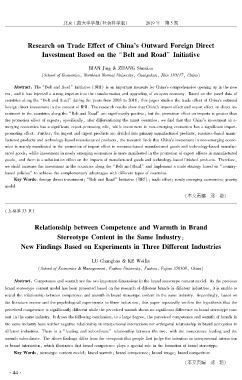Page 49 - 北京工商大学学报2019年第5期
P. 49
北京工商大学学报(社会科学版)摇 摇 摇 摇 2019 年摇 第 5 期
Research on Trade Effect of China蒺s Outward Foreign Direct
Investment Based on the “Belt and Road冶 Initiative
BIAN Jing & ZHANG Shuxiao
(School of Economics, Northeast Normal University, Changchun, Jilin 130117, China)
Abstract: The “Belt and Road冶 Initiative (BRI) is an important measure for China蒺s comprehensive opening up in the new
era, and it has injected a strong impetus into the transformation and upgrading of an open economy. Based on the panel data of
countries along the “Belt and Road冶 during the years from 2003 to 2016, this paper studies the trade effect of China蒺s outward
foreign direct investment in the context of BRI. The research results show that China蒺s import effect and export effect on direct in鄄
vestment in the countries along the “Belt and Road冶 are significantly positive, but the promotion effect on imports is greater than
the promotion effect of exports; specifically, after differentiating the target countries, we find that that China蒺s investment in e鄄
merging economies has a significant export鄄promoting role, while investment in non鄄emerging economies has a significant import鄄
promoting effect. Further, the import and export products are divided into primary manufactured products, resource鄄based manu鄄
factured products and technology鄄based manufactured products, the research finds that China蒺s investment in non鄄emerging econo鄄
mies is mainly manifested in the promotion of import effect in resource鄄based manufactured goods and technology鄄based manufac鄄
tured goods; while investment in newly emerging economies is more manifested in the promotion of export effects in manufactured
goods, and there is a substitution effect on the imports of manufactured goods and technology鄄based finished products. Therefore,
we shold increase the investment in the countries along the “Belt and Road冶 and implement a trade strategy based on “country鄄
based policies冶 to achieve the complementary advantages with different types of countries.
Key Words: foreign direct investment; “Belt and Road冶 Initiative (BRI); trade effect; newly emerging economies; gravity
model
(本文责编摇 邓摇 艳)
(上接第 33 页)
Relationship between Competence and Warmth in Brand
Stereotype Content in the Same Industry:
New Findings Based on Experiments in Three Different Industries
LU Changbao & KE Weilin
(School of Economics & Management, Fuzhou University, Fuzhou, Fujian 350108, China)
Abstract: Competence and warmth are the two important dimensions in the brand stereotype content model. As the previous
brand stereotype content model has been presented based on the research of different brands in different industries, it is unable to
reveal the relationship between competence and warmth in brand stereotype content in the same industry. Accordingly, based on
the literature review and the psychological experiments in three industries, this paper repeatedly verifies the hypothesis that the
perceived competence is significantly different while the perceived warmth shows no significant difference in brand stereotype con鄄
tent in the same industry. It draws the following conclusion: to a large degree, the perceived competence and warmth of brands in
the same industry have neither negative relationship in interpersonal interactions nor orthogonal relationship in brand perception in
different industries. There is a “leading and subordinate冶 relationship between the two, with the competence leading and the
warmth subordinate. The above findings differ from the viewpoint that people first judge the intention in interpersonal interaction
or brand interaction, which illustrates that brand competence plays a special role in the formation of brand stereotype.
Key Words: stereotype content model; brand warmth; brand competence; brand image; brand competition
(本文责编摇 邓摇 艳)
· 4 4 ·

